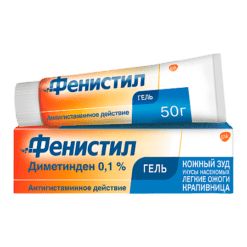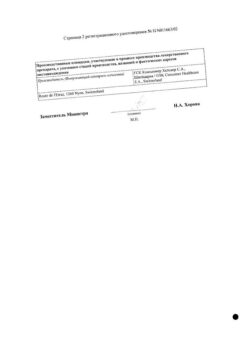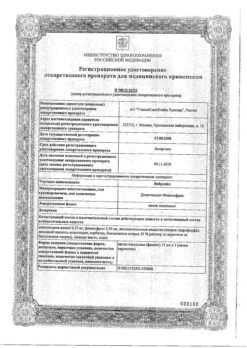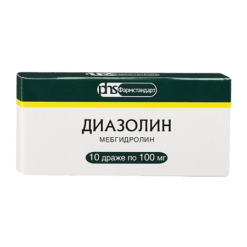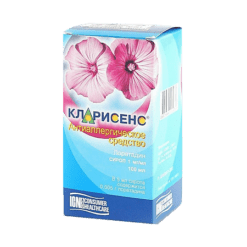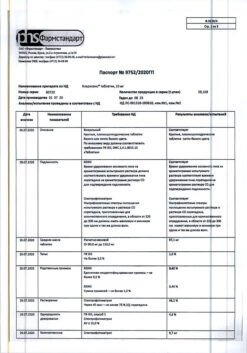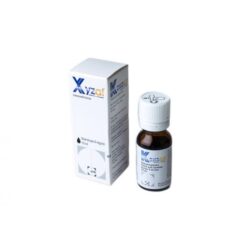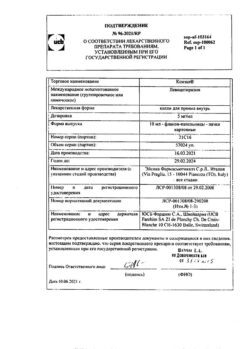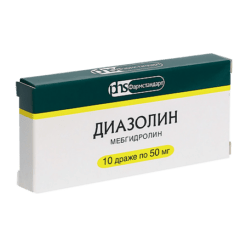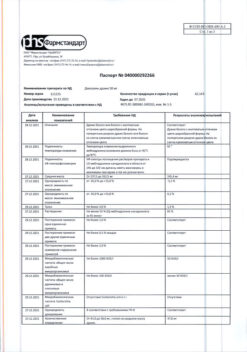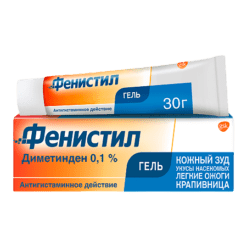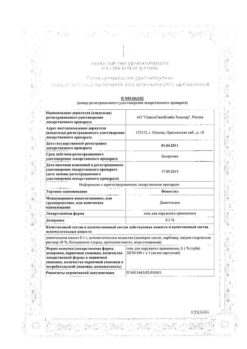No products in the cart.
Description
Zodak express is an anti-allergic.
Pharmacodynamics
Levocetirizine, the (R)-enantiomer of cetirizine, is an inhibitor of peripheral H1-histamine receptors with 2 times higher affinity than that of cetirizine. After a single dose of levocetirizine, there was 90% binding of H1-histamine receptors after 4 h and 57% binding after 24 h.
Levocetirizine has an effect on the histamine-dependent stage of allergic reactions, it reduces migration of eosinophils, decreases vascular permeability, limits release of inflammatory mediators, prevents development and facilitates allergic reactions, has antiexudative and antipruritic effects, practically has no anticholinergic and antiserotonic action, in therapeutic doses it practically has no sedative action.
The action of levocetirizine starts 12 minutes after a single dose in 50% of patients, after 1 hour – in 95% of patients and lasts for 24 hours. Administration of levocetirizine has no effect on the QT interval on ECG.
Pharmacokinetics
The pharmacokinetics of levocetirizine is linear, independent of dose and time and varies slightly in different patients.
Levocetirizine is quickly and completely absorbed from the gastrointestinal tract after oral administration.
Eating does not affect the completeness of absorption, although its rate is reduced.
The plasma Cmax is reached 0.9 h (54 min) after drug administration.
The Css is established after 2 days. Plasma Cmax after a single dose of 5 mg of levocetirizine is 270 ng/ml, and 308 ng/ml after repeated doses of 5 mg.
Levocetirizine is 90% bound to plasma proteins. Vd is 0.4 l/kg. There are no data on distribution of levocetirizine in tissues and its penetration through the BBB in humans.
Levocetirizine is metabolized in small amounts (<14%) in the body by N- and O-dealkylation (unlike other H1-histamine receptor antagonists, which are metabolized in the liver by the cytochrome system) to form a pharmacologically inactive metabolite.
Owing to limited metabolism and absence of metabolic inhibitory activity, interaction of levocetirizine on the metabolic level with other substances is unlikely. T1/2 in adults is 7.9±1.9 h; T1/2 in young children is shorter. The average observed total clearance is 0.63 ml/min/kg.
Levocetirizine is primarily excreted unchanged in the urine, on average, about 85.4% of the administered dose by glomerular filtration and active tubular secretion. Excretion through the intestine (in the feces) is only 12.9% of the taken dose.
Patients with renal insufficiency. Total clearance of levocetirizine depends on creatinine cl. Therefore, in patients with moderate and severe renal insufficiency it is recommended to increase the intervals between doses of the drug according to creatinine Cl. In patients with anuria and terminal renal failure, total clearance of levocetirizine is reduced by approximately 80% compared to healthy subjects. The amount of levocetirizine excreted by a standard 4-hour hemodialysis procedure is less than 10%.
Indications
Indications
Treatment of symptoms of year-round (persistent) and seasonal (intermittent) allergic rhinitis and allergic conjunctivitis, such as itching, sneezing, nasal congestion, rhinorrhea, lacrimation, conjunctival hyperemia;
hay fever (hay fever);
urticaria, including chronic idiopathic urticaria;
Quincke’s edema (as an auxiliary therapy);
other allergic dermatoses, accompanied by itching and rashes.
Pharmacological effect
Pharmacological effect
Zodak Express – antiallergic.
Pharmacodynamics
Levocetirizine, the (R)-enantiomer of cetirizine, is an inhibitor of peripheral histamine H1 receptors, the affinity of which is 2 times higher than that of cetirizine. After a single dose of levocetirizine, binding of H1-histamine receptors was observed by 90% after 4 hours and by 57% after 24 hours.
Levocetirizine has an effect on the histamine-dependent stage of allergic reactions, reduces the migration of eosinophils, reduces vascular permeability, limits the release of inflammatory mediators, prevents the development and facilitates the course of allergic reactions, has an antiexudative, antipruritic effect, has virtually no anticholinergic and antiserotonin effects, and in therapeutic doses has virtually no sedative effect.
The effect of levocetirizine begins 12 minutes after taking a single dose in 50% of patients, after 1 hour in 95% of patients and continues for 24 hours. Taking levocetirizine does not affect the QT interval on the ECG.
Pharmacokinetics
The pharmacokinetics of levocetirizine is linear, independent of dose and time, and varies slightly between patients.
After oral administration, levocetirizine is quickly and completely absorbed from the gastrointestinal tract.
Eating does not affect the completeness of absorption, although its rate is reduced.
Plasma Cmax is achieved 0.9 hours (54 minutes) after taking the drug.
Css installs in 2 days. Plasma Cmax after a single dose of 5 mg of levocetirizine is 270 ng/ml, and after a repeated dose of 5 mg is 308 ng/ml.
Levocetirizine is 90% bound to plasma proteins. Vd is 0.4 l/kg. There are no data on the distribution of levocetirizine in tissues and its penetration through the BBB in humans.
Levocetirizine is metabolized in small quantities (<14%) in the body by N- and O-dealkylation (unlike other H1-histamine receptor antagonists, which are metabolized in the liver via the cytochrome system) to form a pharmacologically inactive metabolite.
Due to limited metabolism and the absence of metabolic inhibitory activity, interaction of levocetirizine at the metabolic level with other substances is unlikely. T1/2 in adults is 7.9±1.9 hours; in young children T1/2 is shortened. The average observed total clearance was 0.63 ml/min/kg.
Levocetirizine is predominantly excreted unchanged in the urine, on average, about 85.4% of the dose taken by glomerular filtration and active tubular secretion. Excretion through the intestines (with feces) is only 12.9% of the dose taken.
Patients with renal failure. The total clearance of levocetirizine depends on creatinine Cl. Therefore, in patients with moderate and severe renal failure, it is recommended to increase the intervals between doses of the drug in accordance with creatinine Cl. In patients with anuria and end-stage renal disease, the total clearance of levocetirizine is reduced by approximately 80% compared to healthy individuals. The amount of levocetirizine excreted during a standard 4-hour hemodialysis procedure is less than 10%.
Special instructions
Special instructions
It is not recommended to take ethanol during treatment with the drug.
Impact on the ability to drive vehicles or engage in other potentially hazardous activities. Levocetirizine, when taken in recommended doses, does not have a negative effect on attention and speed of psychomotor reactions and the ability to drive vehicles. However, during the period of taking the drug, it is advisable to refrain from engaging in potentially hazardous activities that require increased concentration and speed of psychomotor reactions.
Active ingredient
Active ingredient
Levocetirizine
Composition
Composition
Active ingredient:
levocetirizine dihydrochloride 5 mg;
Excipients:
lactose monohydrate – 67.5 mg;
MCC – 25 mg;
sodium carboxymethyl starch – 1 mg;
colloidal silicon dioxide – 0.5 mg;
magnesium stearate – 1 mg;
Film shell:
hypromellose 2910/5 – 3.3 mg;
macrogol 6000 – 0.35 mg;
talc – 0.85 mg;
titanium dioxide (E171) – 0.5 mg
Pregnancy
Pregnancy
Pregnancy
Data on the use of levocetirizine during pregnancy are virtually absent or limited (less than 300 pregnancy outcomes). However, the use of cetirizine, the racemate of levocetirizine, during pregnancy (more than 1000 pregnancy outcomes) was not associated with malformations and intrauterine and neonatal toxic effects. Animal studies have not revealed any direct or indirect adverse effects on pregnancy, embryonic and fetal development, childbirth or postnatal development.
Caution should be exercised when prescribing levocetirizine to pregnant women.
Breastfeeding period
Cetirizine, a racemate of levocetirizine, is excreted in breast milk. Therefore, it is also likely that levocetirizine is excreted in breast milk. Breastfed children may experience adverse reactions to levocetirizine. Therefore, caution must be exercised when prescribing levocetirizine during breastfeeding.
Fertility
There are no clinical data on levocetirizine.
Contraindications
Contraindications
Hypersensitivity to levocetirizine and other piperazine derivatives or to any of the auxiliary components of the drug;
end-stage renal failure with creatinine Cl less than 10 ml/min;
congenital galactose intolerance, lactase deficiency or glucose-galactose malabsorption (due to the lactose content of the drug)
pregnancy;
children under 6 years of age (for this dosage form).
With caution: simultaneous use with alcohol (see “Interaction”); chronic renal failure with creatinine Cl more than 10 ml/min, but less than 50 ml/min (dosage adjustment required); old age (possibly decreased glomerular filtration rate).
Side Effects
Side Effects
From the immune system: very rarely – hypersensitivity reactions, including anaphylactic reactions.
From the nervous system: often – headache; infrequently – drowsiness; very rarely – aggression, agitation, hallucinations, depression, convulsions.
From the organ of vision: very rarely – visual disturbances.
From the heart: very rarely – palpitations, tachycardia.
From the respiratory system, chest and mediastinal organs: very rarely – shortness of breath.
From the gastrointestinal tract: often – dryness of the oral mucosa; infrequently – abdominal pain; very rarely – nausea, diarrhea.
From the liver and biliary tract: very rarely – hepatitis.
From the skin and subcutaneous tissues: very rarely – angioedema, itching, rash, including drug rash, urticaria.
From the musculoskeletal and connective tissue side: very rarely – myalgia.
General disorders: often – fatigue; infrequently – asthenia.
From laboratory and instrumental data: very rarely – impaired liver function indicators, weight gain.
Interaction
Interaction
The interaction of levocetirizine with other drugs, including studies with inducers of the CYP3A4 isoenzyme, has not been studied.
When studying the drug interactions of cetirizine racemate with pseudoephedrine, cimetidine, ketoconazole, erythromycin, azithromycin, glipizide and diazepam, no clinically significant adverse interactions were identified.
When administered simultaneously with theophylline (400 mg/day), the total clearance of cetirizine is reduced by 16% (the kinetics of theophylline does not change).
A study of co-administration of ritonavir (600 mg twice daily) and cetirizine (10 mg daily) showed that cetirizine exposure increased by 40%, while ritonavir exposure was slightly changed (11%).
In sensitive patients, concomitant use of levocetirizine and alcohol or other CNS depressants may potentiate the CNS effects, although cetirizine racemate has not been shown to potentiate the effects of alcohol.
Overdose
Overdose
Symptoms: possible drowsiness and agitation (in adults), as well as anxiety, followed by drowsiness (in children).
Treatment: There are no specific antidotes for levocetirizine. In case of overdose, symptomatic or supportive treatment is recommended. If little time has passed after taking the drug, gastric lavage should be performed. Levocetirizine is practically not excreted during hemodialysis.
Storage conditions
Storage conditions
At a temperature not exceeding 25 °C.
Shelf life
Shelf life
2 years
Manufacturer
Manufacturer
Zentiva k.s., Czech Republic
Additional information
| Shelf life | 2 years |
|---|---|
| Conditions of storage | At a temperature not exceeding 25 °C. |
| Manufacturer | Zentiva k.s., Czech Republic |
| Medication form | pills |
| Brand | Zentiva k.s. |
Related products
Buy Zodak express, 200 mg 7 pcs. with delivery to USA, UK, Europe and over 120 other countries.


